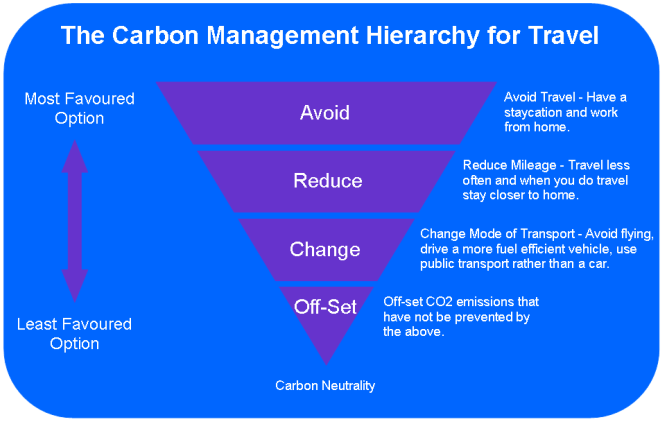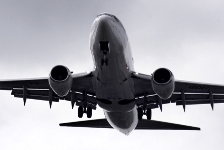Carbon Emissions
Different Modes of Transport

If you are fanatical about reducing your carbon emissions from travelling then walking and cycling are by far the best way to go, closely followed by horses, camels, donkeys, etc, unlikely for most long distance journeys, but you get the idea!
For those of us who don't have a couple of years to spare to travel the world on an ultra low carbon diet then the next best thing to do is probably to go by cargo ship. If you need to cross land then buses and trains are your best options, although a fuel efficient car filled to capacity with passengers is not far behind.
It's actually very difficult to rate one mode of transport against the other as it depends on the fuel efficiency of your mode of transport in terms of what type of fuel it uses, how old it is, what technology it uses, gradients, maximum speeds and stopping patterns, how many people are sharing your journey and a number of other variables.
So, if you end up on the roof of a packed train in India your carbon footprint will be about as close to zero as you can get for over overland travel. If you are travelling 1st class on that same train your carbon footprint will be a lot higher, although you will still be beating the backside of that flight you thought about taking!
Carbon Offsets
In the mid noughties carbon offsetting was seen as a great way to reduce our impact on climate change. More recently it has fallen out of favour as many people simply used it to ease their conscience and continue their high carbon footprint lifestyles. We believe that carbon offsetting still offers an important role in helping humans tackle climate change but it should be the last solution considered, rather than the first! To help explain our thinking on managing carbon emissions from travel we have produced a carbon management hierarchy for travel, which is shown below.
If you are looking at offsetting your carbon emissions from a recent holiday we recommend Less who are a Canadian based organisation.

Why we recommend Less
There are a lot of carbon-offsetting companies on the market; on the face of it they all seem to be offering a similar service. As with any industry some companies are better than others. We have selected Less as they were the top ranked international carbon offsetting company, receiving a strong performance rating from the David Suzuki Foundation in the last review of the Canadian off-setting industry which was undertaken in August 2009. We recognise that this review was specifically for the Canadian market but we have not come across any other industry assessments of this kind in other countries. If you would like to off-set your CO2 emissions from a recent holiday click here to visit the Less website.
Aviation and Carbon

Aircraft currently produce approximately 4% of European Union's CO2 emissions. They also emit nitrogen oxides which lead to the formation of another greenhouse gas, ozone, as well as condensation trails. Research by Jeff Gazzard (www.greenskies.org) indicates that aircraft emissions have 2.7 times of a greater impact at altitude than the same emissions at ground level due to the sensitive nature of the upper atmosphere in which airliners fly.
If the increased impacts of emissions at altitude are taken into account then aircraft emissions already account for approximately 11% of European Union's CO2 emissions. If that was not enough aviation is the fastest-growing contributor to CO2 emissions. As an example, Britain's CO2 emissions from aviation doubled between 1990 and 2000 and are expected to double again by 2030. So rather than being part of the problem why not be part of the solution and make your next trip a flightless one?

The airline industry state that their large commercial airliners are getting more fuel efficient and they are. Airbus states that their Airbus A380 has a fuel efficiency of 3 L/100km per passenger. (We are not sure how accurate this is as we worked it out as 3.9L/100km but let's take them at their word) Some airline industry professionals have been quick to point out that this is more fuel efficient than the new Toyota Prius which has a fuel efficiency of 3.9 L/100km . But hold on, be wary of their cleaver marketing, don't forget a Prius can carry 5 adults giving it a fuel efficiency of 0.78L/100km per passenger.
It is also important to remember the emissions at altitude so if we take Gazzard's 2.7 principle on escalated impact, the damage equates to a single person driving a car with a fuel efficiency of 8.1 litres/100km and if the flight is not full then this can easily equate to an even worse fuel efficiency.
Don't forget it's not just about planes vs. cars, if you take other forms of transport into consideration such as trains and boats, it makes it almost impossible to argue in favour of aeroplanes on fuel efficiency grounds. For example Eurostar recently completed some research which indicated that travelling from London to Paris via train released 90% less carbon emissions than a flight from London to Paris.




